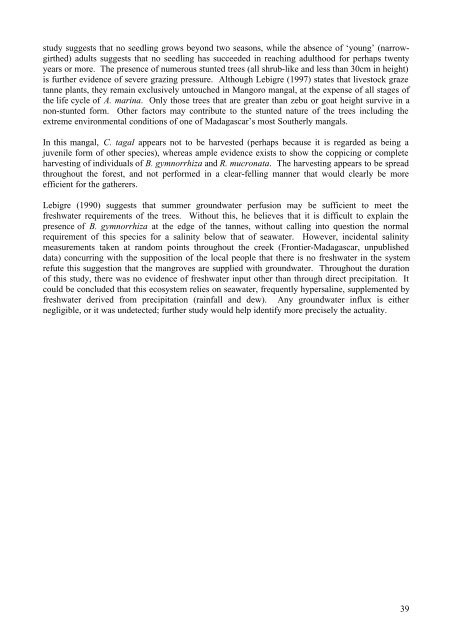Mangrove biodiversity survey south of the Onilahy River - Frontier ...
Mangrove biodiversity survey south of the Onilahy River - Frontier ...
Mangrove biodiversity survey south of the Onilahy River - Frontier ...
Create successful ePaper yourself
Turn your PDF publications into a flip-book with our unique Google optimized e-Paper software.
study suggests that no seedling grows beyond two seasons, while <strong>the</strong> absence <strong>of</strong> ‘young’ (narrowgir<strong>the</strong>d)<br />
adults suggests that no seedling has succeeded in reaching adulthood for perhaps twenty<br />
years or more. The presence <strong>of</strong> numerous stunted trees (all shrub-like and less than 30cm in height)<br />
is fur<strong>the</strong>r evidence <strong>of</strong> severe grazing pressure. Although Lebigre (1997) states that livestock graze<br />
tanne plants, <strong>the</strong>y remain exclusively untouched in Mangoro mangal, at <strong>the</strong> expense <strong>of</strong> all stages <strong>of</strong><br />
<strong>the</strong> life cycle <strong>of</strong> A. marina. Only those trees that are greater than zebu or goat height survive in a<br />
non-stunted form. O<strong>the</strong>r factors may contribute to <strong>the</strong> stunted nature <strong>of</strong> <strong>the</strong> trees including <strong>the</strong><br />
extreme environmental conditions <strong>of</strong> one <strong>of</strong> Madagascar’s most Sou<strong>the</strong>rly mangals.<br />
In this mangal, C. tagal appears not to be harvested (perhaps because it is regarded as being a<br />
juvenile form <strong>of</strong> o<strong>the</strong>r species), whereas ample evidence exists to show <strong>the</strong> coppicing or complete<br />
harvesting <strong>of</strong> individuals <strong>of</strong> B. gymnorrhiza and R. mucronata. The harvesting appears to be spread<br />
throughout <strong>the</strong> forest, and not performed in a clear-felling manner that would clearly be more<br />
efficient for <strong>the</strong> ga<strong>the</strong>rers.<br />
Lebigre (1990) suggests that summer groundwater perfusion may be sufficient to meet <strong>the</strong><br />
freshwater requirements <strong>of</strong> <strong>the</strong> trees. Without this, he believes that it is difficult to explain <strong>the</strong><br />
presence <strong>of</strong> B. gymnorrhiza at <strong>the</strong> edge <strong>of</strong> <strong>the</strong> tannes, without calling into question <strong>the</strong> normal<br />
requirement <strong>of</strong> this species for a salinity below that <strong>of</strong> seawater. However, incidental salinity<br />
measurements taken at random points throughout <strong>the</strong> creek (<strong>Frontier</strong>-Madagascar, unpublished<br />
data) concurring with <strong>the</strong> supposition <strong>of</strong> <strong>the</strong> local people that <strong>the</strong>re is no freshwater in <strong>the</strong> system<br />
refute this suggestion that <strong>the</strong> mangroves are supplied with groundwater. Throughout <strong>the</strong> duration<br />
<strong>of</strong> this study, <strong>the</strong>re was no evidence <strong>of</strong> freshwater input o<strong>the</strong>r than through direct precipitation. It<br />
could be concluded that this ecosystem relies on seawater, frequently hypersaline, supplemented by<br />
freshwater derived from precipitation (rainfall and dew). Any groundwater influx is ei<strong>the</strong>r<br />
negligible, or it was undetected; fur<strong>the</strong>r study would help identify more precisely <strong>the</strong> actuality.<br />
39
















